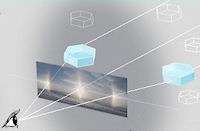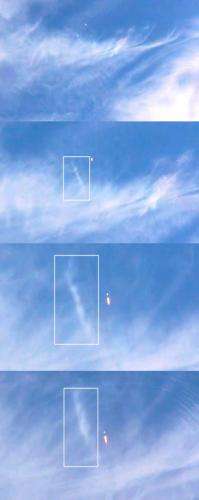Solar Dynamics Observatory sundog mystery

]NASA's Solar Dynamics Observatory (SDO), best known for cutting-edge images of the sun, has made a discovery right here on Earth.
"It's a new form of ice halo," says atmospheric optics expert Les Cowley of England. "We saw it for the first time at the launch of SDO--and it is teaching us new things about how shock waves interact with clouds."

Ice halos are rings and arcs of light that appear in the sky when sunlight shines through ice crystals in the air. A familiar example is the sundog—a rainbow-colored splash often seen to the left or right of the morning sun. Sundogs are formed by plate-shaped ice crystals drifting down from the sky like leaves fluttering from trees.
Last year, SDO destroyed a sundog—and that's how the new halo was discovered.
SDO lifted off from Cape Canaveral on Feb. 11, 2010—one year ago today. It was a beautiful morning with only a handful of wispy cirrus clouds crisscrossing the wintry-blue sky. As the countdown timer ticked to zero, a sundog formed over the launch pad.
"When the rocket penetrated the cirrus, shock waves rippled through the cloud and destroyed the alignment of the ice crystals," explains Cowley. "This extinguished the sundog."
The sundog's destruction was understood. The events that followed, however, were not.
"A luminous column of white light appeared next to the Atlas V and followed the rocket up into the sky," says Cowley. "We'd never seen anything like it."
Cowley and colleague Robert Greenler set to work figuring out what the mystery-column was. Somehow, shock waves from the rocket must have scrambled the ice crystals to produce the 'rocket halo.' But how? Computer models of sunlight shining through ice crystals tilted in every possible direction failed to explain the SDO event.
[PIC=53471:leftThen came the epiphany: The crystals weren't randomly scrambled, Cowley and Greenler realized. On the contrary, the plate-shaped hexagons were organized by the shock waves as a dancing army of microscopic spinning tops.
Cowley explains their successful model: "The crystals are tilted between 8 and 12 degrees. Then they gyrate so that the main crystal axis describes a conical motion. Toy tops and gyroscopes do it. The earth does it once every 26000 years. The motion is ordered and precise."
Bottom line: Blasting a rocket through a cirrus cloud can produce a surprising degree of order. "This could be the start of a new research field—halo dynamics," he adds.
The simulations show that the white column beside SDO was only a fraction of a larger oval that would have appeared if the crystals and shock waves had been more wide-ranging. A picture of the hypothetical complete halo may be found here.
"We'd love to see it again and more completely," says Cowley.
"If you ever get a once-in-a-lifetime opportunity to be at a rocket launch," he advises with a laugh, "forget about the rocket! Look out instead for halos."
Provided by JPL/NASA




















